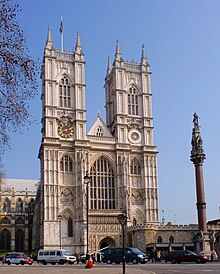
Back Westminster-abdy Afrikaans Westminster Abbey ALS دير وستمنستر Arabic دير ويستمينستر ARZ Abadía de Westminster AST Vestminster abbatlığı Azerbaijani وست مینیستر کیلیساسی AZB Вестминстер аббатлығы Bashkir Вэстмінстэрскае абацтва Byelorussian Ўэстмінстэрскае абацтва BE-X-OLD
| Westminster Abbey | |
|---|---|
| Collegiate Church of Saint Peter at Westminster | |
 Westminster Abbey's western façade | |
| Location | Dean's Yard, London, SW1 |
| Country | England |
| Denomination | Church of England |
| Previous denomination | Roman Catholic Church |
| Website | westminster-abbey |
| History | |
| Status | Collegiate church |
| Founded | c. 959 |
| Consecrated | 28 December 1065, 13 October 1269 |
| Architecture | |
| Functional status | Active |
| Heritage designation | UNESCO World Heritage Site |
| Designated | 1987 |
| Specifications | |
| Nave width | 85 feet (26 m)[1] |
| Height | 101 feet (31 m)[1] |
| Floor area | 32,000 square feet (3,000 m2)[1] |
| Number of towers | 2 |
| Tower height | 225 feet (69 m)[1] |
| Materials | Reigate stone; Portland stone; Purbeck marble |
| Bells | 10 |
| Administration | |
| Diocese | Extra-diocesan (royal peculiar) |
| Clergy | |
| Dean | David Hoyle |
| Canon(s) | see Dean and Chapter |
| Laity | |
| Director of music | Andrew Nethsingha (Organist and Master of the Choristers) |
| Organist(s) | Peter Holder (sub-organist) Matthew Jorysz (assistant) |
| Organ scholar | Dewi Rees |
| Coordinates | 51°29′58″N 00°07′39″W / 51.49944°N 0.12750°W |
| Founded | c. 959 |
| Official name | Palace of Westminster, Westminster Abbey and Saint Margaret's Church |
| Type | Cultural |
| Criteria | i, ii, iv |
| Designated | 1987 (11th session) |
| Reference no. | 426 |
| Country | United Kingdom |
| Region | Europe and North America |
Listed Building – Grade I | |
| Official name | Westminster Abbey (The Collegiate Church of St Peter) |
| Designated | 24 February 1958 |
| Reference no. | 1291494[2] |
Westminster Abbey, formally titled the Collegiate Church of Saint Peter at Westminster, is an Anglican church in the City of Westminster, London, England. Since 1066, it has been the location of the coronations of 40 English and British monarchs and a burial site for 18 English, Scottish, and British monarchs. At least 16 royal weddings have taken place at the abbey since 1100.
Although the origins of the church are obscure, an abbey housing Benedictine monks was on the site by the mid-10th century. The church got its first large building from the 1040s, commissioned by King Edward the Confessor, who is buried inside. Construction of the present church began in 1245 on the orders of Henry III. The monastery was dissolved in 1559, and the church was made a royal peculiar – a Church of England church, accountable directly to the sovereign – by Elizabeth I. The abbey, the Palace of Westminster and St. Margaret's Church became a UNESCO World Heritage site in 1987 because of their historic and symbolic significance.
The church's Gothic architecture is chiefly inspired by 13th-century French and English styles, although some sections of the church have earlier Romanesque styles or later Baroque and modern styles. The Henry VII Chapel, at the east end of the church, is a typical example of Perpendicular Gothic architecture; antiquarian John Leland called it orbis miraculum ("the wonder of the world").
The abbey is the burial site of more than 3,300 people, many prominent in British history: monarchs, prime ministers, poets laureate, actors, scientists, military leaders, and the Unknown Warrior. Due to the fame of the figures buried there, artist William Morris described the abbey as a "National Valhalla".
- ^ a b c d "Dimensions of Westminster Abbey" (PDF). Westminster Abbey. Archived (PDF) from the original on 4 March 2016. Retrieved 12 January 2016.
- ^ "Westminster Abbey (The Collegiate Church of St Peter)". Historic England. Archived from the original on 14 May 2022. Retrieved 30 January 2023.
© MMXXIII Rich X Search. We shall prevail. All rights reserved. Rich X Search
